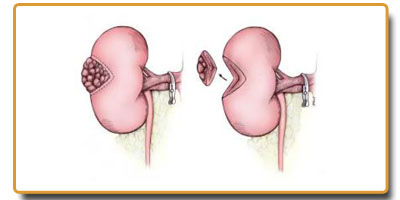
The patients with renal tumours usually have special CT scans which helps the surgeon to plan as whether partial nephrectomy could be performed .
During the operation, the kidney and its blood vessels are mobilised; the blood supply to the kidney is stopped for a short while (usually less than 30 min) ; during this time, the tumour with a small margin of normal kidney is cut out; bleeding areas are carefully sutured; any open calyces are sutured; the cut surface is the opposed by a process called renorrhaphy. After the kidney is reconstructed, the blood flow to the kidney is restored by removing the vascular clamps which are on the blood vessels supplying the kidney. The kidney is inspected to ensure there is no bleeding from where the kidney was cut. Generally, the tumour is removed from the body through one of the holes.
Because of the complexity of this surgery, patients may have a higher chance of postoperative complications from a robotic partial nephrectomy instead of a robotic radical nephrectomy, which is a removal of the total kidney.
However partial nephrectomy has an advantage that the patients have a slightly lower incidence of cardiovascular and renal diseases in future.
Postoperatively patients are discharged usually on day 1 or 2 and are back to complete normal activity by 4-6 weeks. Depending upon the nature of the tumour careful follow up is planned.
